101+ Empowered ChatGPT Prompts for eBooks to Boost Your Creative Writing
Ever wondered how to spark creativity and engagement in your eBook writing journey? Get a glimpse of the world of powerful ChatGPT Prompts for eBooks. Crafted to simplify the process, these custom-built ChatGPT Prompts guide the AI to generate compelling content, making your eBooks creation a breeze.
Ever faced the daunting challenge of articulating your ideas seamlessly in eBook writing? Do you find yourself staring at a blank page, uncertain of how to infuse creativity into your content? Many grapple with these hurdles, struggling to navigate the complexities of expression. ChatGPT Prompts for ebooks step in as the solution, offering a tailored approach to streamline your writing process and transform these common obstacles into opportunities for engaging and impactful storytelling.
Embark on a literary journey with ChatGPT Prompts for Ebooks, as readers anticipate a seamless fusion of creativity and guidance. Unlock the power to effortlessly craft compelling narratives that resonate deeply, elevating your storytelling prowess to new heights.
How ChatGPT Prompts for Ebooks Boost Your Productivity!
When it comes to the benefits of utilizing ChatGPT Prompts for Ebooks, consider the impact on your projects, time, and overall efficiency. Our pre-built prompts act as a compass, guiding you through the complicated process of generating AI-driven content for Ebooks. By eliminating the need for extensive prompt crafting, these prompts empower you to focus on your core tasks, boosting effectiveness and making you stand out in the competitive digital space. In a nutshell, ChatGPT Prompts for Ebooks offer a seamless and time-efficient solution, ensuring your AI projects not only meet deadlines but also exceed expectations.
In the dynamic landscape of AI, crafting optimized ChatGPT prompts can be a time-consuming challenge for busy professionals deeply immersed in the AI realm. According to recent surveys, 70% of AI professionals in the USA struggle with prompt optimization, hindering their ability to fully harness ChatGPT’s potential. However, by offering pre-built prompts tailored for Ebooks, I provide a time-saving solution. This not only saves professionals the hassle of prompt creation but also ensures they can efficiently leverage ChatGPT’s capabilities, enhancing productivity and staying ahead in the fast-paced AI landscape.
Boost Creativity with ChatGPT’s Expert Prompt for Ebooks Success
Act like You are an award-winning eBook writer. Your task is to assist me in structuring and writing content for my ebook. I’d like to pen an eBook about [Input your Details] for [Business name].
Avoid mentioning anything about your role as the author — the focus should remain firmly on the content and its relevance to the readers.
First of all, the nature of my eBook is [informational/motivational/instructional/a combination of these]. The context for my ebook is [It is about [Input TOPIC] and other specific and important details about it are [Input Necessary Details]]. My target audience is [Input Demographics and region of your TARGET AUDIENCE]. So while writing content. Make sure you write content according to that.
Now suggest a captivating and intriguing title based on my topic. Tone I want for the titles is (serious/playful/motivational/other). Suggest total of 5 titles. A great title and subtitle will mark the difference between my ebook being memorable and forgettable. Don’t make the title too long or complicated. Avoid using jargon or complex terms. Must Not use numbers in the title. The title should indicate [mention what the eBook is about]. The title should be a single and cohesive statement.
As an expert in [Input Your Topic], your task is to brainstorm 2 different structures for an eBook aimed at my TARGET AUDIENCE. Outline each structure with distinct headings for each section and step.
Ensure logical flow of points and content relevancy. Provide a brief description of the content that will be covered in each step.
Do not write whole chapters at once. You are the author of an eBook titled “[TITLE]”. Your task is to craft an enticing introduction for a chapter named “[CHAPTER TITLE]”. The introduction should hook the reader and convince them of the necessity of reading the full chapter.
Could you suggest some chapter themes? Can you help find scholarly articles, studies, and expert opinions related to my topic?
First generate a title. Then Create structures. Then Generate outlines. Then generate content. But firstly ask me as many questions as you need for the information for writing an ebook. You can ask me about every type of specification about my ebook.
Firstly ask me and collect data then generate titles and provide me with titles only. When I say “Title is ok” then you share 2 structure ideas with me. I will check them and regenerate as per need. When I tell you “structure is ok and with which structure i will continue” then create an outline for me and I will let you know if i am ok with the outline. Then you will start generating content for the 1st chapter. I will confirm that you will create content for the next chapter. And so on.
In your writing, avoid jargon that could potentially confuse or distance the reader. Stick to simple and understandable language. Compose the introduction from the perspective of a motivational coach speaking to a reader who might be feeling lost and confused. Your role is to guide, inspire, and light the path for them through the content of this chapter. Your ultimate aim is to captivate the reader’s interest and compel them to read the entire chapter.
Note (How to use this prompt): Please add input values clearly and briefly. This prompt will firstly create only the title for your ebook. Once you are ok with the title then give feedback to ChatGPT. ChatGPT will move on further. And provide you with 2 structures of your ebook. You have to choose one of them. After choosing chatgpt will start generating content for 1 chapter at a time. You will share feedback and it will move on to the next chapter then. Just be patient and it will be very fruitful for you.
3 Impactful ChatGPT Prompts for Captivating Ebooks
- Crafting a Captivating Title for eBook:
My eBook is [informational/motivational/instructional/a combination of these]. The context for my ebook is [It is about [Input TOPIC] and other specific and important details about it are [Input Necessary Details]]. My target audience is [Input Demographics and region of your TARGET AUDIENCE]. So while writing content. Make sure you write content according to that.
Now suggest a captivating and intriguing title based on my topic. Tone I want for the title is (serious/playful/motivational/other). Suggest total of 5 titles. A great title and subtitle will mark the difference between my ebook being memorable and forgettable. Don’t make the title too long or complicated. Avoid using jargon or complex terms. Must not use numbers in the title. The title should indicate [mention what the eBook is about]. The title should be a single and cohesive statement.
- Brainstorming eBook Structure:
As an expert in [Input Your Topic], your task is to brainstorm 2 different structures for an eBook aimed at my TARGET AUDIENCE. Outline each structure with distinct headings for each section and step. Ensure logical flow of points and content relevancy. Provide a brief description of the content that will be covered in each step.
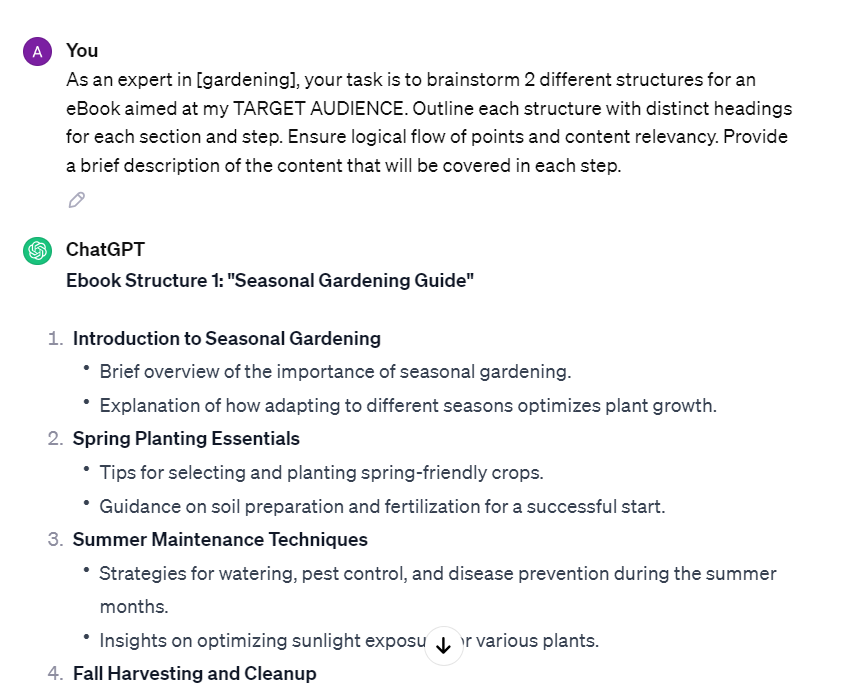
- Crafting Resonant Themes for eBook:
Discuss the importance of developing resonant themes in my storytelling. How can overarching themes add depth and meaning to the narrative?
101+ Innovative ChatGPT Prompts for Crafting Spellbinding eBooks
- Craft the Perfect Opening:
Explore different approaches to crafting a captivating story beginning. What elements make readers eager to delve into my book from the first page?
- Develop Engaging Characters in My Stories:
Explore strategies for creating compelling and relatable characters in my stories. How can I make them memorable and resonate with readers?
- Build Gripping Plot Twists:
Examine techniques for building unexpected and gripping plot twists. How can I keep readers on the edge of my seat throughout my narrative?
- Craft Memorable Endings:
Discuss approaches to crafting satisfying and memorable endings. What elements contribute to a conclusion that resonates with readers?
- Master Dialogue Writing:
Dive into the art of writing authentic and impactful dialogue. What tips can elevate my characters’ conversations and drive the narrative forward?
- Create World-Building Magic:
Discuss methods for building immersive and believable worlds in my writing. How can I transport readers to fantastical or realistic settings?
- Navigate Point of View:
Discuss the nuances of choosing the right point of view for my narrative. How does it impact my connection with the story and characters?
- Balance Show and Tell:
Delve into the art of balancing descriptive “showing” and informative “telling” in my writing. How can I maintain a dynamic narrative flow?
- Overcome Writer’s Block:
Provide strategies to overcome writer’s block and keep the creative juices flowing. How can I reignite inspiration when faced with a creative standstill?
- Perfect Pacing Techniques:
Explore the importance of pacing in storytelling. How can I maintain a rhythm that keeps readers engaged and invested in my narrative?
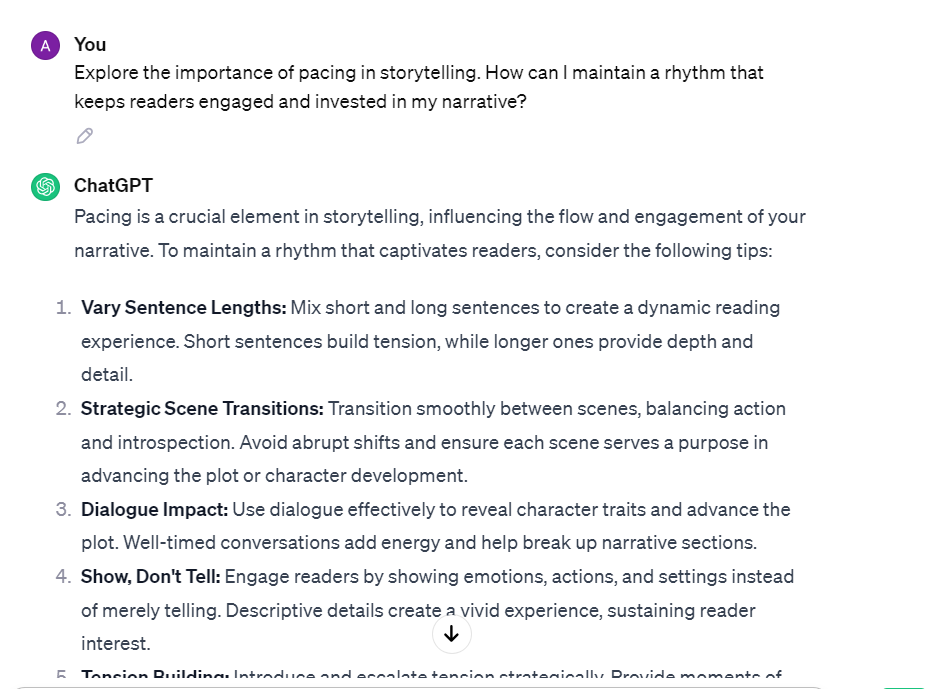
- Effective Self-Editing Tips:
Discuss practical tips for effective self-editing. What steps can I take to polish my manuscript and refine my writing style?
- Develop Engaging Subplots:
Guide writers in creating engaging subplots that complement the main story arc. How can subplots enhance the overall narrative experience?
- Understand Genre Dynamics:
Explore the conventions and expectations of different genres. How can writers navigate and effectively deliver on genre-specific elements?
- Utilize Symbolism in Writing:
Explore the power of symbolism in storytelling. How can writers incorporate symbols to add depth and layers to my narratives?
- Navigate Cultural Sensitivity:
Provide insights into writing with cultural sensitivity. How can authors respectfully and authentically represent diverse cultures in their work?
- Market My Ebook Effectively:
Share effective strategies for marketing and promoting my ebook. How can authors build an online presence and connect with their target audience?
- Harness Emotional Impact:
Explore techniques to evoke strong emotions in my readers. How can I create a deep emotional connection between my characters and audience?
- Write for Different Platforms:
Discuss considerations for adapting my writing style for different platforms, such as blogs, social media, or traditional publishing.
- Explore Collaborative Writing:
Explore the possibilities of collaborative writing projects. How can authors successfully collaborate with others to create a cohesive and engaging story?
- Embrace Feedback in Writing:
Guide writers on how to seek, receive, and incorporate feedback effectively. How can constructive criticism contribute to the improvement of my manuscript?
- Develop Dynamic Conflict Resolution:
Explore techniques for creating and resolving conflicts in my stories. How can conflict be used to drive the narrative and develop characters?
- Crafting Authentic Relationships:
Dive into strategies for writing genuine and impactful relationships between characters. How can I portray connections that resonate with readers?
- Enhance Emotional Resonance:
Examine methods to deepen emotional connections in my writing. How can I evoke specific emotions and make readers empathize with characters?
- Crafting Unforgettable Settings:
Discuss the art of crafting memorable settings in my stories. How can vivid descriptions enhance the overall atmosphere of my narrative?
- Navigating Genre Blending:
Explore the creative possibilities of blending genres in my writing. How can combining elements from different genres create unique and engaging narratives?
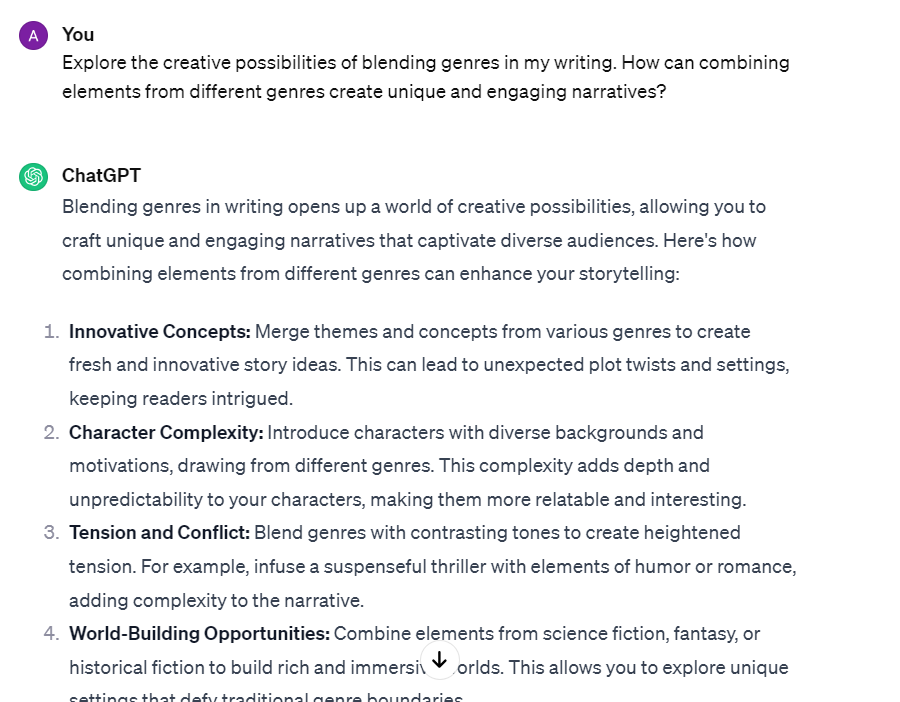
- Create Multi-Dimensional Antagonists:
Develop strategies for crafting complex and multi-dimensional antagonists. How can I make the reader empathize with or understand the motivations of the antagonist?
- Effective Use of Foreshadowing:
Discuss the art of foreshadowing in storytelling. How can I strategically plant hints and clues to build anticipation and suspense in my narrative?
- Revise and Polish Dialogue:
Provide tips for revising and polishing dialogue in my manuscript. How can I ensure that characters’ conversations are impactful and contribute to the overall story?
- Leverage Flashbacks Effectively:
Explore the use of flashbacks in storytelling. How can flashbacks be employed to provide context, deepen characterization, and advance the plot?
- Building Unpredictable Endings:
Discuss techniques for crafting endings that surprise and resonate with readers. How can unexpected twists leave a lasting impact on the audience?
- Develop Compelling Side Characters:
Guide writers in creating compelling side characters. How can these characters contribute to the richness and depth of my narrative?
- Mastering Tension and Suspense:
Explore methods for building tension and suspense in my writing. How can I keep readers eagerly turning pages to discover what happens next?
- Creating Atmosphere with Descriptive Language:
Discuss the importance of descriptive language in setting the atmosphere of my stories. How can vivid descriptions immerse readers in the world I’ve created?
- Strengthening Internal Monologues:
Examine techniques for writing powerful internal monologues. How can expressing characters’ thoughts and emotions enhance the reader’s connection to the story?
- Writing Compelling Openings for Chapters:
Explore strategies for crafting compelling openings for individual chapters. How can each chapter begin in a way that captures the reader’s attention?
- Developing Consistent Narration Style:
Discuss the importance of maintaining a consistent narration style throughout my manuscript. How can consistency contribute to a cohesive reading experience?
- Balancing Action and Reflection:
Examine the balance between action sequences and moments of reflection in my writing. How can these elements work together to create a dynamic narrative?
- Mastering the Art of Subtext:
Explore the subtleties of conveying subtext in dialogue and narrative. How can implied meanings add depth and complexity to my characters and story?
- Crafting Endearing Protagonists:
Guide writers in creating endearing protagonists. How can readers connect with and root for the main characters throughout my narrative?
- Utilizing Symbolic Motifs:
Discuss the use of recurring symbolic motifs in storytelling. How can these motifs enhance themes and create a cohesive narrative structure in my work?
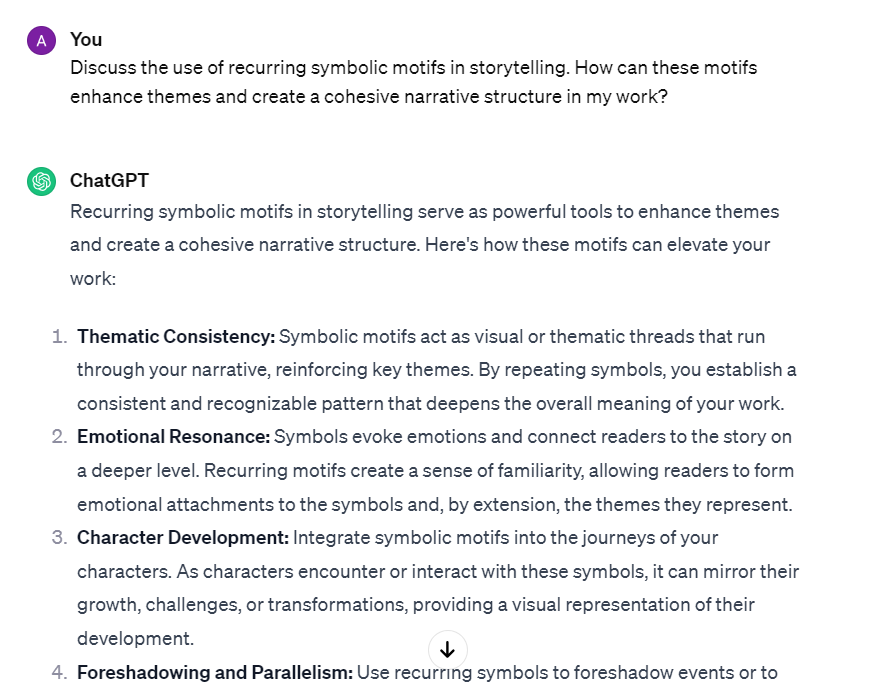
- Enhancing Descriptive Action Scenes:
Explore techniques for enhancing descriptive language in action scenes. How can detailed descriptions heighten the excitement and impact of key moments?
- Crafting Unforgettable Opening Lines:
Discuss strategies for creating memorable opening lines. How can a powerful first sentence captivate readers and set the tone for my entire story?
- Navigating Time Jumps:
Explore the effective use of time jumps in storytelling. How can transitions between different time periods contribute to the narrative structure?
- Developing Unique Character Motivations:
Guide writers in crafting distinct and compelling motivations for characters. How can characters’ goals drive the plot and create engaging story arcs?
- Perfecting Pitches and Synopses:
Provide tips for crafting compelling pitches and synopses for my ebook. How can concise yet impactful descriptions attract potential readers?
- Utilizing Humor in Writing:
Explore the art of incorporating humor into my writing. How can well-timed comedic elements enhance the reader’s enjoyment of the narrative?
- Mastering Character Arcs:
Examine techniques for crafting satisfying character arcs. How can characters evolve and undergo meaningful changes throughout my story?
- Writing for Diverse Audiences:
Guide writers in considering and addressing diverse audiences in my writing. How can inclusivity and representation enrich the overall narrative?
- Incorporating Cultural Influences:
Explore ways to incorporate cultural influences into my storytelling. How can diverse cultural elements enhance authenticity and broaden the reader’s perspective?
- Developing Intriguing Backstories:
Explore methods for crafting intriguing and compelling backstories for characters. How can characters’ pasts add depth and complexity to my narrative?
- Crafting Multi-POV Narratives:
Discuss the challenges and benefits of crafting narratives with multiple points of view. How can switching perspectives enhance the storytelling experience?
- Creating Dynamic Chapter Endings:
Explore strategies for crafting dynamic endings to individual chapters. How can strong conclusions keep readers invested in the unfolding narrative?
- Balancing Exposition and Action:
Examine the balance between exposition and action in my writing. How can information be seamlessly integrated without slowing down the narrative pace?
- Crafting Unconventional Story Structures:
Discuss the creative possibilities of unconventional story structures. How can experimenting with narrative formats add uniqueness to my storytelling?
- Incorporating Symbolic Colors:
Explore the use of symbolic colors in storytelling. How can color choices convey themes, emotions, or character traits in my narrative?

- Writing Engaging Epilogues:
Discuss strategies for crafting satisfying and engaging epilogues. How can a well-crafted epilogue provide closure and leave a lasting impression?
- Crafting Effective Cliffhangers:
Explore techniques for creating compelling cliffhangers at the end of chapters. How can suspenseful endings keep readers eager to turn the page?
- Developing Atmosphere through Sound:
Discuss the role of sound in creating atmosphere in my storytelling. How can incorporating auditory elements enhance the immersive experience for readers?
- Crafting Sequels and Series:
Guide writers in planning and crafting sequels or series. How can continuity and fresh storytelling be balanced to maintain reader interest across multiple books?
- Writing Evocative Nature Descriptions:
Explore techniques for crafting evocative descriptions of nature in my writing. How can vivid depictions of landscapes enhance the overall atmosphere of my story?
- Developing Unique Magic Systems:
Discuss strategies for creating unique and engaging magic systems in my fantasy world. How can magical elements contribute to the narrative and character development?
- Crafting Memorable Opening Scenes:
Dive into the art of crafting memorable opening scenes. How can a compelling initial scene captivate readers and draw them into my narrative?
- Exploring Genre Mashups:
Explore the creative possibilities of genre mashups. How can blending different genres add originality and excitement to my storytelling?
- Creating Authentic Dialects:
Discuss techniques for writing authentic dialects in dialogue. How can unique speech patterns enhance character authenticity without becoming confusing?
- Enhancing Symbolic Animal Motifs:
Explore the use of symbolic animal motifs in storytelling. How can animal symbolism be incorporated to convey themes and character traits?
- Crafting Unique Character Habits:
Guide writers in developing distinctive habits for characters. How can recurring habits add depth and authenticity to my characters?
- Writing Engaging Flash Fiction:
Discuss the challenges and strategies for crafting engaging flash fiction. How can a limited word count be maximized for impact and resonance?
- Utilizing Unreliable Narrators:
Explore the use of unreliable narrators in storytelling. How can the unreliability of the narrator create intrigue and suspense in my narrative?
- Building Emotional Resilience in Characters:
Discuss methods for building emotional resilience in characters. How can characters overcome challenges and grow stronger emotionally throughout my story?
- Crafting Effective Inciting Incidents:
Explore strategies for crafting effective inciting incidents that propel the story forward. How can a powerful incident set the tone for the entire narrative?
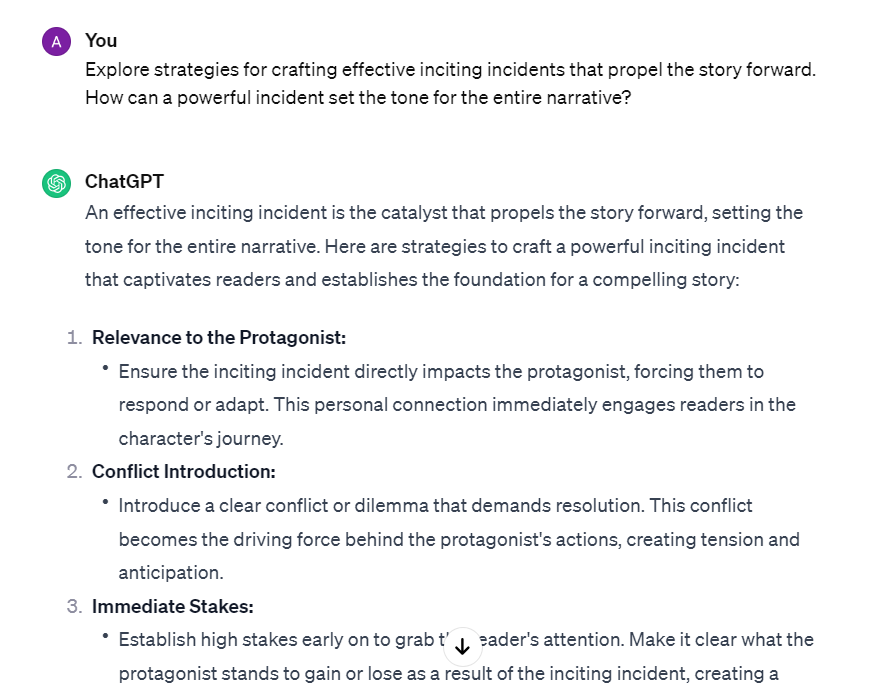
- Writing Compelling Science Fiction Concepts:
Dive into the art of crafting compelling science fiction concepts. How can futuristic ideas and technologies be seamlessly integrated into my storytelling?
- Developing Unique Character Flaws:
Guide writers in developing unique and impactful character flaws. How can flaws contribute to character growth and add layers to the narrative?
- Balancing Narration and Dialogue:
Discuss the balance between narration and dialogue in my writing. How can effective dialogue complement and enhance the overall storytelling?
- Creating Inclusive Fantasy Worlds:
Explore methods for creating inclusive fantasy worlds that represent diverse perspectives and cultures. How can inclusivity enrich my fantasy narrative?
- Crafting Effective Chapter Titles:
Discuss strategies for crafting chapter titles that intrigue and encapsulate the essence of each chapter. How can chapter titles enhance the reader’s experience?
- Exploring Magical Realism:
Dive into the genre of magical realism. How can elements of magic seamlessly coexist with the ordinary in my narrative to create a unique literary experience?
- Developing Authentic Character Motivations:
Guide writers in developing authentic and relatable motivations for characters. How can characters’ goals resonate with readers on a personal level?
- Writing Emotionally Impactful Endings:
Discuss techniques for crafting emotionally impactful endings. How can a well-crafted conclusion leave a lasting impression on the reader?
- Crafting Effective Book Blurbs:
Provide tips for crafting compelling book blurbs. How can a concise yet engaging blurb entice potential readers and give them a glimpse into my story?
- Crafting Mystery and Suspense:
Explore techniques for crafting mystery and suspense in my storytelling. How can suspenseful elements keep readers intrigued and guessing?
- Developing Character Relationships:
Guide writers in developing meaningful relationships between characters. How can diverse relationships contribute to character development and plot progression?
- Building Cultural Richness:
Dive into the art of building cultural richness in my narratives. How can cultural elements enhance the authenticity and depth of my world-building?
- Utilizing Symbolic Weather:
Explore the use of symbolic weather patterns in storytelling. How can weather serve as a metaphor and add layers of meaning to my narrative?
- Crafting Ethical Dilemmas:
Discuss strategies for crafting ethical dilemmas that challenge characters. How can moral quandaries add complexity and depth to the narrative?
- Mastering Multiple Timelines:
Explore the challenges and benefits of mastering multiple timelines in storytelling. How can different time periods contribute to the complexity of my narrative?
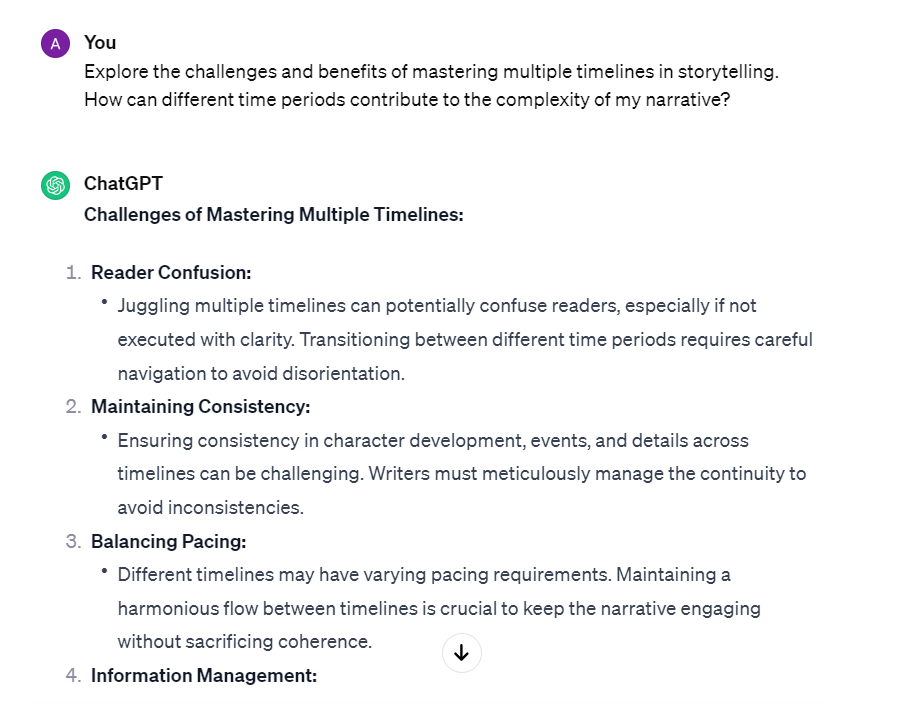
- Writing Diverse Perspectives:
Guide writers in incorporating diverse perspectives in my storytelling. How can multiple viewpoints enrich the narrative and offer a well-rounded experience?
- Crafting Powerful Revelations:
Discuss techniques for crafting powerful and surprising revelations in my storytelling. How can unexpected twists captivate readers and reshape the narrative?
- Developing Introspective Character Moments:
Explore methods for crafting introspective moments for characters. How can internal reflections enhance character depth and emotional resonance?
- Utilizing Symbolic Objects:
Dive into the use of symbolic objects in storytelling. How can specific items carry symbolic weight and contribute to the thematic elements of my narrative?
- Writing Powerful Back Cover Copy:
Provide tips for writing compelling back cover copy. How can a well-crafted synopsis on the back cover entice readers and convey the essence of my story?
- Crafting Dynamic Action Sequences:
Explore techniques for crafting dynamic and engaging action sequences. How can well-paced action keep readers on the edge of their seats?
- Developing Personal Growth Arcs:
Guide writers in crafting personal growth arcs for characters. How can characters overcome challenges and evolve emotionally throughout my narrative?
- Creating Realistic Dialogue Exchanges:
Discuss strategies for creating realistic and engaging dialogue exchanges. How can natural-sounding conversations contribute to character authenticity?
- Utilizing Symbolic Colors:
Explore the use of symbolic colors in storytelling. How can color choices convey themes, emotions, or character traits in my narrative?
- Writing Engaging Epistolary Fiction:
Dive into the art of writing engaging epistolary fiction. How can storytelling through letters, emails, or diary entries create a unique narrative structure?
- Developing Historical Authenticity:
Guide writers in developing historical authenticity in my narratives. How can accurate historical details enhance the immersive experience for readers?
- Crafting Unreliable Narrators:
Explore the nuances of crafting unreliable narrators. How can the unreliability of the narrator create intrigue and suspense in my narrative?
- Building Atmospheric Horror:
Discuss techniques for building atmospheric horror in my writing. How can setting, pacing, and tension contribute to a chilling and immersive experience?
- Mastering the Art of Red Herrings:
Explore the use of red herrings in storytelling. How can misleading clues and false leads add complexity and suspense to the unfolding narrative?
- Crafting Dynamic Character Entrances:
Explore techniques for crafting impactful character entrances. How can a character’s introduction create a lasting impression and set the tone for their role in the narrative?
- Building Engaging Plot Devices:
Dive into the creation of engaging plot devices in your stories. How can unique and clever devices propel the narrative forward and captivate readers?
- Developing Unconventional Story Endings:
Explore the art of crafting unconventional and thought-provoking endings. How can departing from traditional conclusions leave a lasting impact on the reader?
- Crafting Emotional Resonance Through Music:
Discuss the incorporation of music to evoke emotional resonance in storytelling. How can musical elements enhance the mood and depth of my narrative?
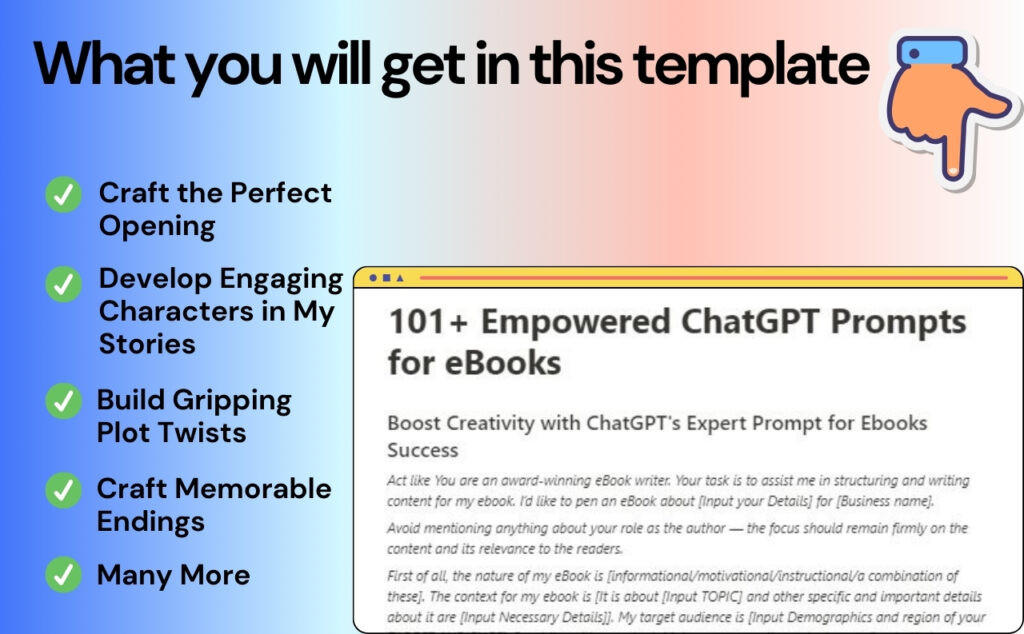
ChatGPT Prompts for Ebooks PDF Download
Ready to create an ebook that wows readers? Look no further! ChatGPT’s Prompts for Ebooks PDF is here to help. Packed with easy-to-follow ideas, this guide will spark your creativity and make writing your ebook a breeze. No more staring at a blank page – just download the PDF, follow the prompts, and watch your ebook come to life. Don’t let your ideas go to waste – get your free copy today and start writing your best ebook yet with ChatGPT!
Get 99+ ChatGPT Prompts for eBooks – Complete List Here!
Free Prompts forever – Complete eBooks Prompts List
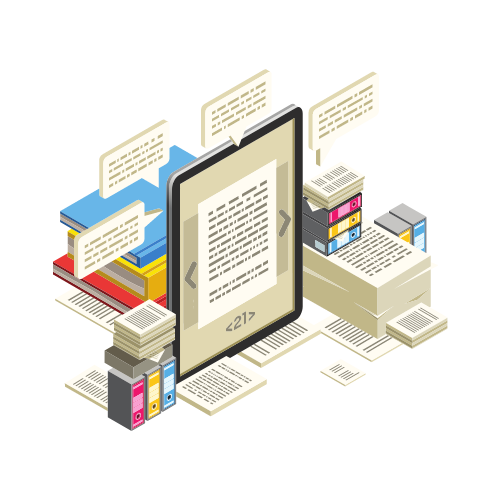
Final Thoughts
In wrapping up, harnessing ChatGPT prompts for eBooks is your shortcut to streamlined content creation. For busy AI enthusiasts, these pre-built prompts offer a time-saving solution, sparing you the effort of crafting optimized queries. Embrace the ease, let your writing flourish, and elevate your content effortlessly. Happy writing!

